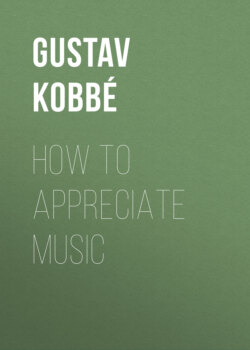Читать книгу How to Appreciate Music - Gustav Kobbé - Страница 12
На сайте Литреса книга снята с продажи.
The Harpsichord.
ОглавлениеIf you chance to be listening to a Hungarian band at a restaurant you may notice that one of the players has lying on a table before him an instrument with many strings strung very much like those of the pianoforte. It is played with two little mallets in the player’s hands, and produces the weird arpeggios and improvised runs characteristic of Hungarian gypsy music. It is a very old instrument called the cembalo. About the fifteenth century, it seems, some one devised a keyboard attachment with quills for this instrument, tipped the jacks with crow-quills, and called the result a clavicembalo (a cembalo with keys). This was the origin of the harpsichord, the name by which the clavicembalo soon became more generally known. Harpsichords were shaped somewhat like our grand pianofortes, but were much smaller. A spinet was a small harpsichord, and the virginal a still smaller one. Sometimes, indeed, virginals were made no larger than workboxes, 43 the instrument being taken out of the box and placed on a table before the player.
For the purposes of this book this very general survey of the precursors of the pianoforte seems sufficient. The clavichord and the instruments of the harpsichord (harpsichord, spinet, and virginal) class flourished alongside of each other, but the best musicians gave the preference to the clavichord because of its sweet tone and the delicately tremulous effect that could be produced upon it by the balancement. Experiments in pianoforte making were in progress already in Bach’s day, but he clung to the clavichord, as did his son, Philipp Emanuel Bach. Mozart was the first of the great masters to realize the value of the pianoforte and to aid materially in making it popular by using it for his public performances. And yet even then the clavichord, “that lonely, melancholy, unspeakably sweet instrument,” was not abandoned without lingering regret by the older musicians, and it still was to be found in occasional use as late as the beginning of the last century. How thoroughly modern the pianoforte is will be appreciated when it is said that a celebrated firm of English makers founded in 1730 did not begin to manufacture pianofortes until 1780 and continued the production of clavichords until 1793.
